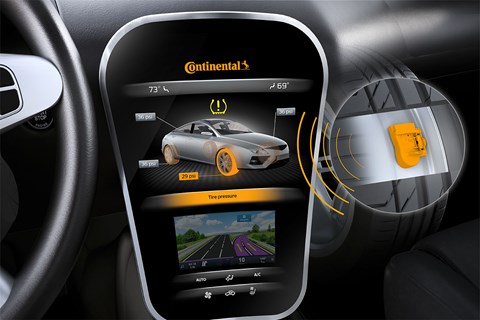► Tyres that communicate with the car
► In-tyre sensors monitor spin and slip
► Safety benefits could be huge
Continental has developed new tyre technology that promises to revolutionise Electronic Stability Control (ESC). Currently, tyres are the only part of the car that grips the road surface, but also one of few relevant components that have no input into ESP algorithms.
‘Existing sensors respond quickly, but they’re still waiting to react to the onset of slip,’ points out Continental automotive engineering manager Richard Durance ‘If the tyre itself could feed into the ESC, the limits would be detected earlier and the vehicle’s systems could adjust to better maximise the friction and grip potential.’
And that’s just what Continental has in mind…
1) ESC: it’s a life-saver
Mandatory on all cars sold in the EU since 2014, ESC is a proven life-saver: a Department for Transport study found cars equipped with ESC are 25% less likely to be involved in a fatal accident than those without.
ESC builds on ABS braking, bringing skids under control by quickly applying braking force to individual wheels, and sometimes reducing power. Today’s ESC systems use a yaw-control sensor, wheel-speed sensors and steering-angle sensors to detect that a car is starting to skid. Continental’s breakthrough goes straight to the source of the problem: the tyre.
2) How it works
The tech is known as eTIS, or electronic Tyre Information System. Integrated into the inner liner of each tyre, sensors monitor wheelspin and slip and convey information via an RF link direct to the car’s computer. eTIS can also replace today’s mandatory tyre-pressure monitors, and may weigh less, depending on an OEM’s battery life requirements. The potential contribution to road safety is huge: one in three new cars sold in Europe has Continental tyres.
3) There’s more too
The benefits of eTIS can extend beyond stopping skids. It can relay the loads placed on each tyre, track mileage covered and calculate tyre life by monitoring a tyre’s gradually changing rolling characteristics. Communication with other road users is also possible: eTIS could detect ice and warn other cars via cloud-based internet systems.

4) The catch
Continental could sell the technology to other tyre companies, but so far rivals are lukewarm to the idea. It could mean that only one tyre gains OEM approval, which might cause a headache on a Saturday at Kwik Fit.
5) Not the stretch it sounds
If it sounds like uncharted territory for Continental, it isn’t. Tyres account for just 28% of the company’s business, the rest is braking systems, chassis technology and electronic stability control, through its €11.4bn acquisition of Siemens VDO in 2007.
Read more tech features